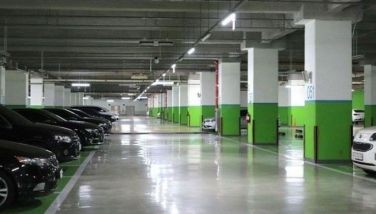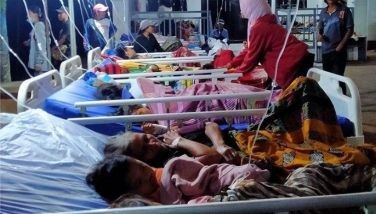Makiling’s a volcano, but inactive — Phivolcs
August 10, 2006 | 12:00am
LOS BAÑOS, Laguna — Mt. Makiling is, indeed, a volcano, but an inactive one, and communities around the fabled destination should not fear that it would someday explode.
Renato Solidum Jr., director of the Philippine Institute of Volcanology and Seismology (DOST-Phivolcs), gave this assurance as Filipinos are hounded these days by reports of unrest of a number of volcanoes, foremost of which is Mayon Volcano in Albay.
By being inactive, Makiling has had no recorded eruptions and its form is being altered by weathering and erosion through the formation of deep and long gullies.
"Makiling is considered inactive. It has no historical record of eruption. The youngest dated deposit is 100,000 years old," Solidum said at a science forum held recently at the Southeast Asian Regional Center for Graduate Study and Research in Agriculture here.
His lecture capped the observance of the National Science and Technology Week by the Los Baños Science Community (LBSC).
The symposium was sponsored by the LBSC Foundation Inc., which had for its theme "Saving Lives, Improving Lives through S&T."
The term volcano, according to Solidum, signifies a vent, hill, or mountain from which molten or hot rocks with gaseous materials are extruded.
He allayed the fears and anxiety of people in communities around Makiling, particularly those in Laguna and Batangas, that it would explode.
Makiling, which is 1,109 meters high, is "a volcano in the Laguna-Batangas corridor of volcanoes," he said, adding that it is typically a "strato-volcano" (formed by different layers).
The "corridor" straddles Taal Volcano, Mt. Banahaw, and the seven lakes of San Pablo City in Laguna, which he described as the "Maar volcanoes."
Even Talim Island in the middle of Laguna Lake is part of a big volcano, which is also inactive, unlike Taal (which has more than 30 craters) and Banahaw.
Solidum, however, said that although Makiling is inactive, it has volcanic activity manifested by boiling mud pools or so-called "mud springs," thermal springs, and fumaroles or holes in a volcanic region from which hot gases and vapors are emitted.
"Makiling is also the source of the Los Baños hot springs," he said.
Moreover, Makiling is a geothermal resource, as exemplified by the Makiling-Banahaw (Mak-Ban) project covering Laguna and Batangas.
The 426-kilowatt Mak-Ban plants supply 15 percent of the electricity required by Luzon.
Makiling’s fertile volcano soil is also good for agriculture.
The Makiling forest, which hosts a variety of plant and animal species, is ideal for enjoying Nature and camping.
Solidum said Makiling is one of the 300 volcanoes in the country, of which 22 are considered active (with recorded eruption within the past 10,000 years).
Renato Solidum Jr., director of the Philippine Institute of Volcanology and Seismology (DOST-Phivolcs), gave this assurance as Filipinos are hounded these days by reports of unrest of a number of volcanoes, foremost of which is Mayon Volcano in Albay.
By being inactive, Makiling has had no recorded eruptions and its form is being altered by weathering and erosion through the formation of deep and long gullies.
"Makiling is considered inactive. It has no historical record of eruption. The youngest dated deposit is 100,000 years old," Solidum said at a science forum held recently at the Southeast Asian Regional Center for Graduate Study and Research in Agriculture here.
His lecture capped the observance of the National Science and Technology Week by the Los Baños Science Community (LBSC).
The symposium was sponsored by the LBSC Foundation Inc., which had for its theme "Saving Lives, Improving Lives through S&T."
The term volcano, according to Solidum, signifies a vent, hill, or mountain from which molten or hot rocks with gaseous materials are extruded.
He allayed the fears and anxiety of people in communities around Makiling, particularly those in Laguna and Batangas, that it would explode.
Makiling, which is 1,109 meters high, is "a volcano in the Laguna-Batangas corridor of volcanoes," he said, adding that it is typically a "strato-volcano" (formed by different layers).
The "corridor" straddles Taal Volcano, Mt. Banahaw, and the seven lakes of San Pablo City in Laguna, which he described as the "Maar volcanoes."
Even Talim Island in the middle of Laguna Lake is part of a big volcano, which is also inactive, unlike Taal (which has more than 30 craters) and Banahaw.
Solidum, however, said that although Makiling is inactive, it has volcanic activity manifested by boiling mud pools or so-called "mud springs," thermal springs, and fumaroles or holes in a volcanic region from which hot gases and vapors are emitted.
"Makiling is also the source of the Los Baños hot springs," he said.
Moreover, Makiling is a geothermal resource, as exemplified by the Makiling-Banahaw (Mak-Ban) project covering Laguna and Batangas.
The 426-kilowatt Mak-Ban plants supply 15 percent of the electricity required by Luzon.
Makiling’s fertile volcano soil is also good for agriculture.
The Makiling forest, which hosts a variety of plant and animal species, is ideal for enjoying Nature and camping.
Solidum said Makiling is one of the 300 volcanoes in the country, of which 22 are considered active (with recorded eruption within the past 10,000 years).
BrandSpace Articles
<
>
- Latest
- Trending
Trending
Latest
Trending
Latest
Recommended





























